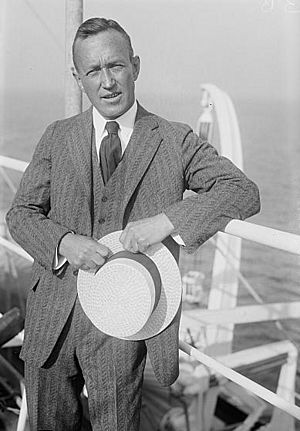Lincoln Ellsworth facts for kids
Quick facts for kids
Lincoln Ellsworth
|
|
|---|---|

Lincoln Ellsworth
|
|
| Born | May 12, 1880 |
| Died | May 26, 1951 (aged 71) |
| Nationality | United States |
| Occupation | exploration |
| Parent(s) | James Ellsworth Eva Frances Butler |
Lincoln Ellsworth (born May 12, 1880 – died May 26, 1951) was a brave American explorer. He loved to travel to the coldest places on Earth, like the North and South Poles. He was also a big supporter of the American Museum of Natural History.
Contents
Lincoln Ellsworth's Life and Adventures
Lincoln Ellsworth was born in Chicago, Illinois, on May 12, 1880. His parents were James Ellsworth and Eva Frances Butler. As a child, he also lived in Hudson, Ohio.
Early Life and Education
Lincoln went to The Hill School. It took him a bit longer to finish high school than most students. After that, he went to Yale University, Columbia University, and McGill University. However, he decided to end his college studies early.
First Arctic Flights
Lincoln Ellsworth's father, James, was a very rich man who made his money in coal. He gave US$100,000 to help fund a big adventure in 1925. This was for Roald Amundsen's plan to fly from Svalbard to the North Pole.
Lincoln Ellsworth joined Amundsen on this journey. They used two special flying boats called Dornier Wals, named N24 and N25. On May 21, they set off to reach the North Pole.
Challenges on the Ice
During their flight, one airplane lost power. This forced both planes to land on the ice, and they became separated. It took three days for the crews to find each other again. They then spent 28 days trying to get their plane, N25, back into the air. They finally succeeded after seven tries!
Sadly, Lincoln's father, James, passed away in Italy on June 2, 1925. He was waiting for news about his son's lost expedition.
Flying Over the North Pole
In March 1926, the New York Times newspaper announced a new expedition. It was called the Amundsen-Ellsworth Expedition. Their goal was to fly "Across the Pole by Dirigible."
Lincoln Ellsworth joined Roald Amundsen again for this second attempt. This time, they used a large airship called the Norge. It was designed and flown by an Italian engineer named Umberto Nobile. They flew from Svalbard all the way to Alaska. On May 12, they saw the Geographic North Pole from the airship. This was a huge achievement!
Exploring Antarctica
Between 1933 and 1939, Lincoln Ellsworth made four trips to Antarctica. For these expeditions, he used a former Norwegian herring boat. He named it Wyatt Earp after a famous American hero. This boat served as his aircraft carrier and base.
Discovering Mountains
On November 23, 1935, Ellsworth made a very important discovery. He found the Ellsworth Mountains in Antarctica. He did this during a flight across Antarctica, from Dundee Island to the Ross Ice Shelf. He named a part of these mountains the Sentinel Range.
During this flight, his aircraft ran out of fuel. He and his pilot, Herbert Hollick-Kenyon, had to land near a camp called Little America. This camp had been set up by another famous explorer, Richard Byrd.
Lost and Found
Because their radio was broken, Ellsworth and Hollick-Kenyon could not tell anyone where they were. People thought they were missing. A British research ship, the Discovery, sailed from Melbourne, Australia to search for them.
After almost two months alone at Little America, the two men were found on January 16, 1936. They returned to New York City on April 6. Their support ship, the MS Wyatt Earp, arrived two weeks later.
Many places in Antarctica are named after Lincoln Ellsworth. These include Ellsworth Land, Mount Ellsworth, and Lake Ellsworth.
Honors and Recognition
Lincoln Ellsworth received many awards for his amazing explorations.
Boy Scouts of America
In 1927, the Boy Scouts of America made Lincoln Ellsworth an Honorary Scout. This was a new award created that year. It was given to Americans whose outdoor adventures were so special they inspired young boys.
Ellsworth's essay, "The First Crossing of the Polar Sea," was included in a book called The Boy Scout's Book of True Adventure, Fourteen Honorary Scouts. The United States Postal Service even put his picture on a stamp once. Today, the sports teams in Hudson, Ohio, where he lived as a child, are nicknamed "The Explorers" in his honor.
Congressional Gold Medals
In 1928, Ellsworth was given a Congressional Gold Medal. This medal honored his flights to the North Pole in 1925 and 1926.
Eight years later, in 1936, he received a second Congressional Gold Medal. This was for claiming about 350,000 square miles in Antarctica for the United States. It was also for his 2,500-mile flight survey over the heart of Antarctica. This made him one of only four people to ever receive two Congressional Gold Medals.
The former Antarctic base Ellsworth Station was also named after him.
Other Awards
In 1937, Ellsworth received the Patron's Gold Medal from the Royal Geographical Society. This award was for improving how pilots navigate in the polar regions from the air.
The Hall of Lincoln Ellsworth at the American Museum of Natural History is dedicated to his incredible journeys to the Arctic and Antarctic.
See also
 In Spanish: Lincoln Ellsworth para niños
In Spanish: Lincoln Ellsworth para niños

